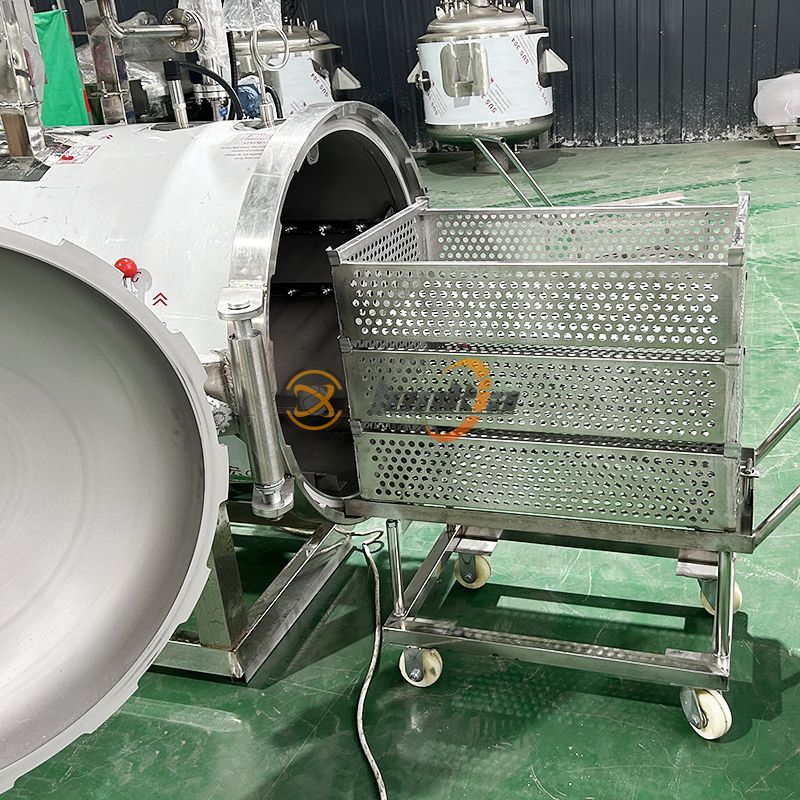If you work in food processing, pharmaceuticals, or packaging, you’ve likely heard both terms: retort machine and food autoclave. While these devices are often discussed separately, their functions overlap so closely that many professionals use the names interchangeably. Let’s break down their similarities, subtle differences, and why choosing the right terminology matters for your operations.

1. Definitions: Retort Machine vs. Food Autoclave
- Retort Machine: A pressurized vessel that uses steam and high temperatures (typically 240°F–280°F) to sterilize packaged foods, ensuring microbial safety and extended shelf life. Common in canning and ready-to-eat meal production.
- Food Autoclave: A specialized autoclave designed for food industry applications, functioning under similar pressure and heat principles to eliminate pathogens in sealed containers.
Key Takeaway: Both devices achieve thermal processing and sterilization through pressurized steam. The term “retort” is more common in food manufacturing, while “autoclave” is broader (used in labs and healthcare).
2. How Do They Work? Nearly Identical Processes
Whether labeled a retort machine or food autoclave, their core operation follows three stages:
- Loading: Pre-packaged products (cans, pouches, trays) are loaded into the chamber.
- Sterilization: Steam raises the temperature to 121°C (250°F) under pressure, killing bacteria like C. botulinum.
- Cooling: Rapid cooling locks in nutrients and prevents overcooking.
Pro Tip: Both require precise control of pressure, temperature, and cycle time to meet FDA and HACCP standards.
3. Key Applications: Where They Shine
Retort Machine Uses
- Commercial canning (vegetables, soups, meats).
- Ready-to-eat meals (retort pouches for camping/hiking food).
- Pet food sterilization.
Food Autoclave Uses
- Laboratory food testing (sterilizing equipment).
- Small-batch artisanal food preservation (e.g., jams, sauces).
- Pre-packaged organic products requiring gentle sterilization.
Overlap: Both are critical for achieving commercial sterility and complying with food safety regulations.
4. Design Differences: What Sets Them Apart?
While functionally similar, minor distinctions exist:
Feature | Retort Machine | Food Autoclave |
Scale | Large industrial batches | Smaller, flexible capacities |
Automation | Often fully automated | May require manual operation |
Customization | Tailored for pouches/cans | Generic container compatibility |
Cost | Higher initial investment | Budget-friendly for SMEs |
Note: Modern industrial autoclaves now blur these lines, offering hybrid features.
5. Why the Confusion? Terminology in Context
- Historical Usage: “Retort” originates from chemical processing, while “autoclave” is rooted in medical sterilization.
- Regional Preferences: U.S. food manufacturers favor “retort machine”; European suppliers may use “food autoclave” more broadly.
- Marketing Strategies: Some brands differentiate products by target audience (e.g., “retort” for food, “autoclave” for labs).
6. Choosing Between a Retort Machine and Food Autoclave
Ask these questions before investing:
Production Volume: High-volume lines need industrial retort machines; small batches may opt for food autoclaves.
Packaging Type: Retorts excel with flexible packaging (pouches), while autoclaves handle diverse containers.
Compliance Needs: Ensure the equipment meets FDA 21 CFR 113 (low-acid canned foods) or ISO 17665 (steam sterilization).
Expert Advice: Reputable manufacturers like [Your Company] offer hybrid solutions adaptable to both labels.
7. Maintenance Tips for Both Systems
- Clean seals and valves weekly to prevent steam leaks.
- Calibrate temperature sensors monthly.
- Use purified water to avoid mineral buildup.
- Schedule annual inspections for pressure safety.
Two Names, One Goal
While retort machines and food autoclaves may differ in scale and terminology, their purpose remains identical: delivering safe, shelf-stable products through precision sterilization. Understanding these nuances ensures you select the right equipment—or realize you need both!
Need Help Deciding? Contact us today for a free consultation on retort machines and food autoclaves tailored to your production needs.

